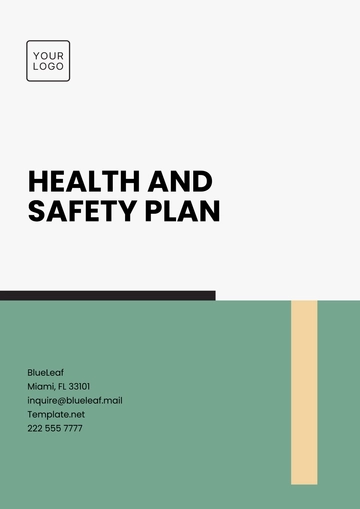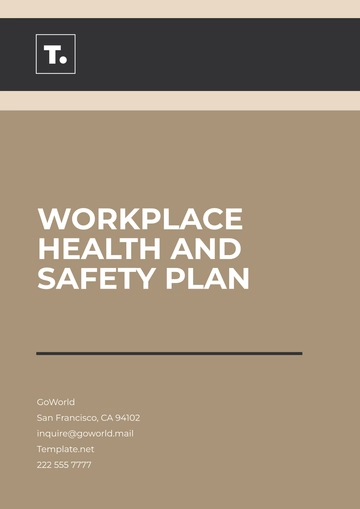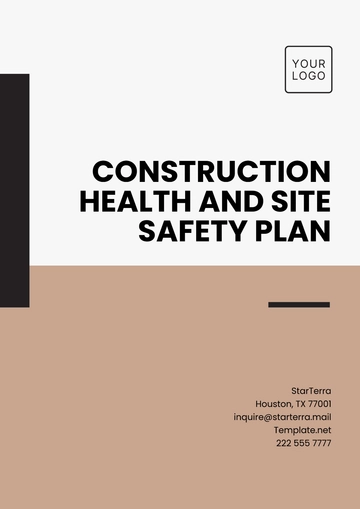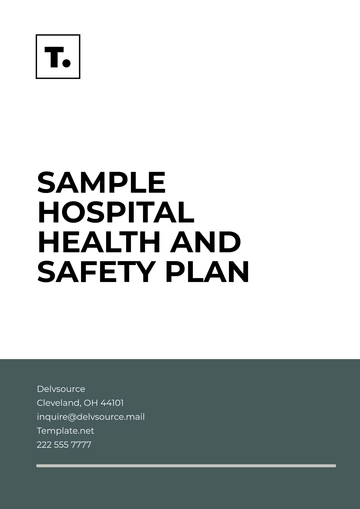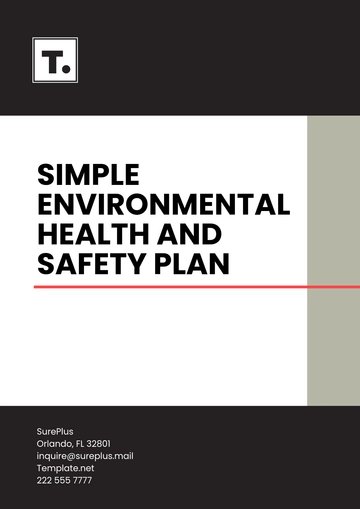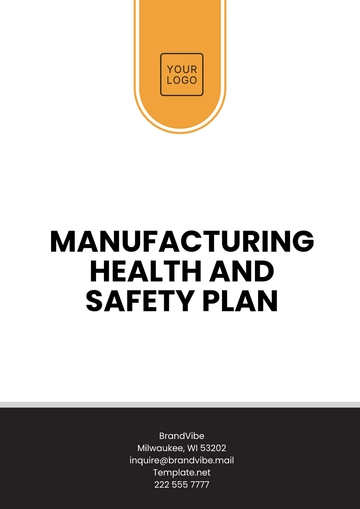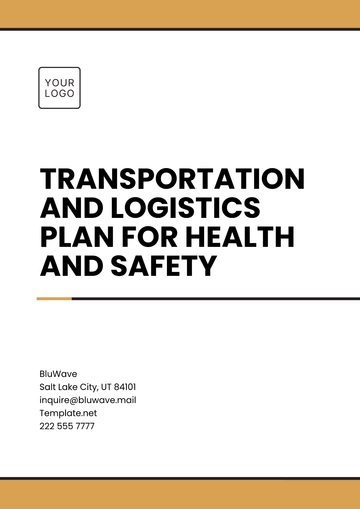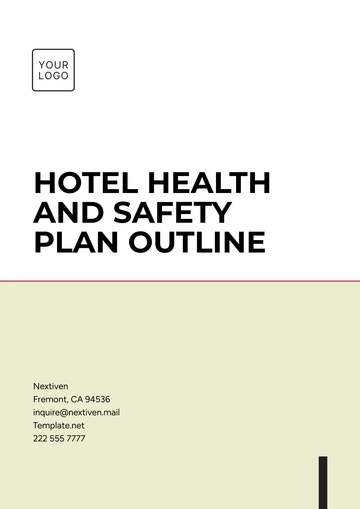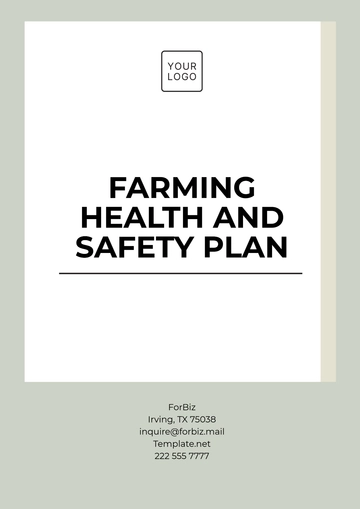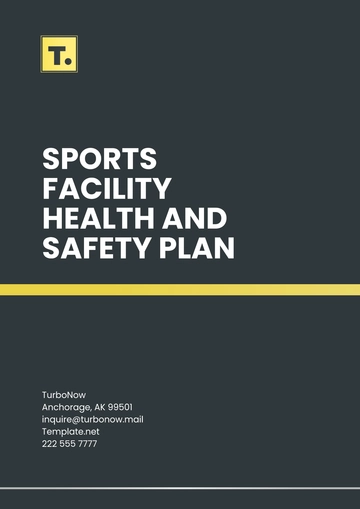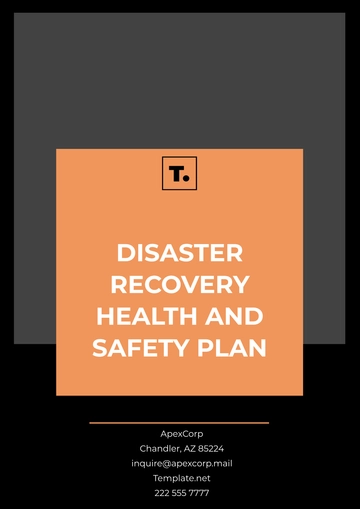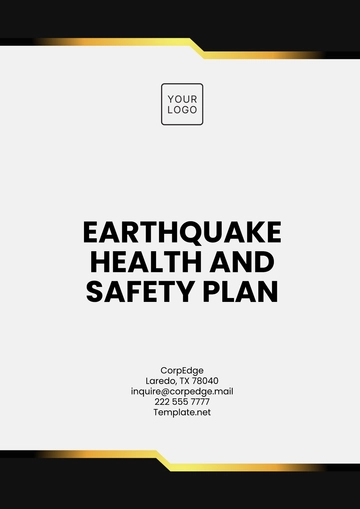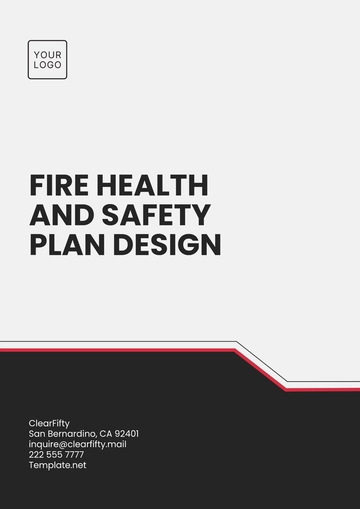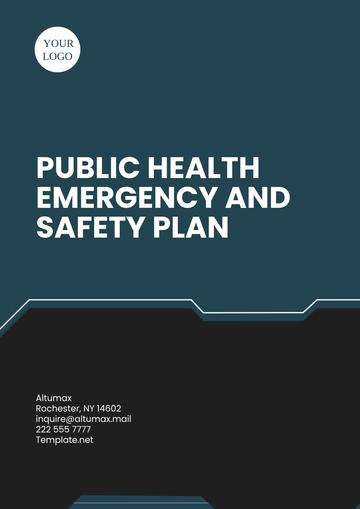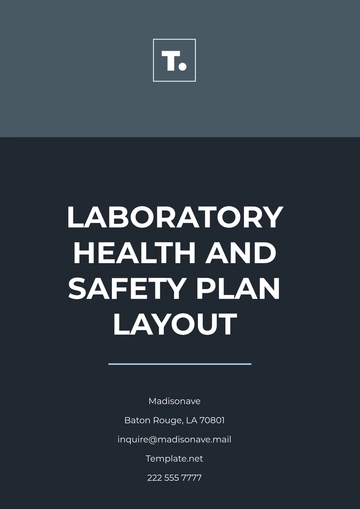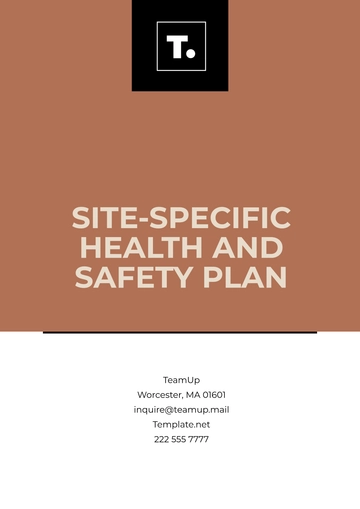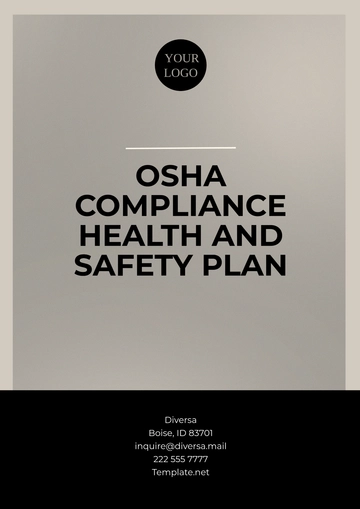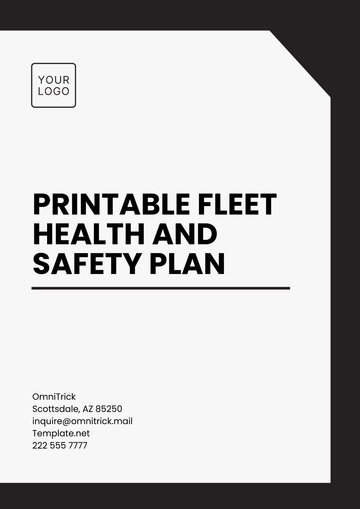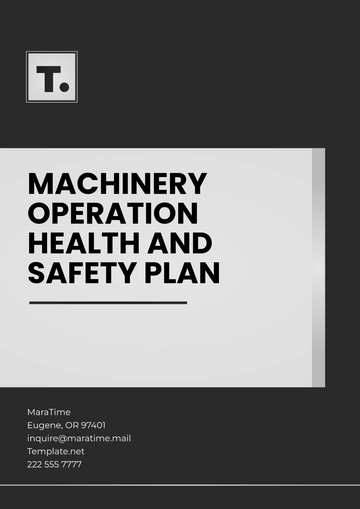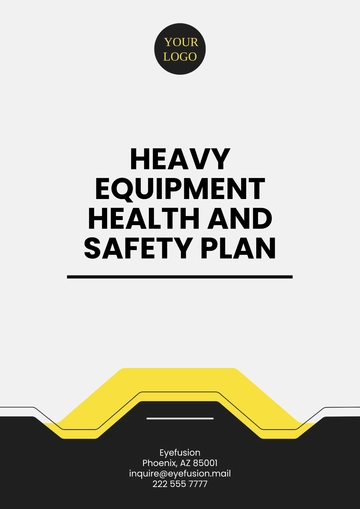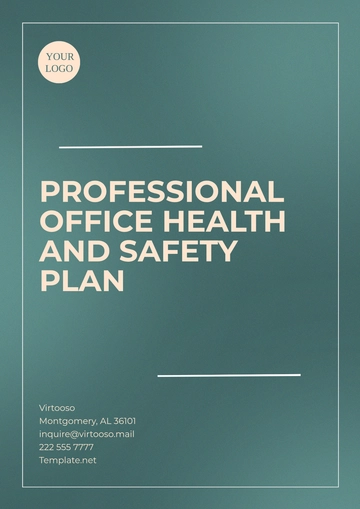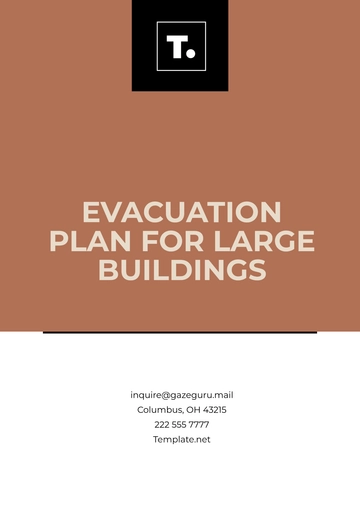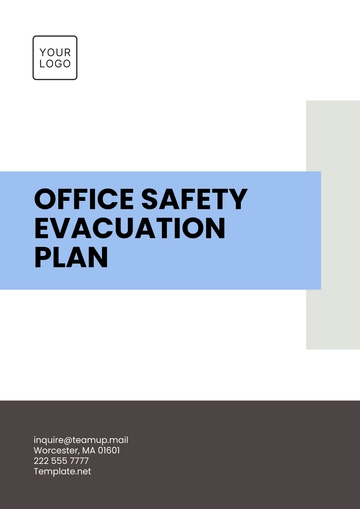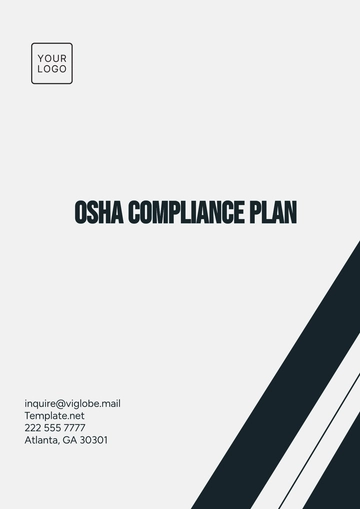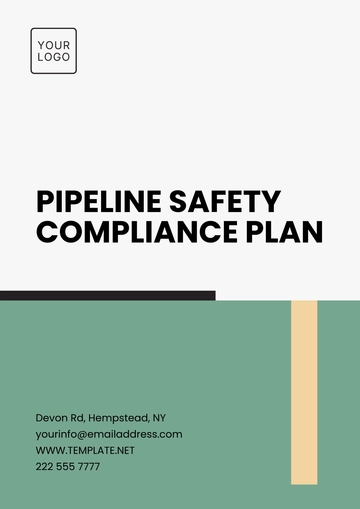Free Health & Safety Awareness Plan Document
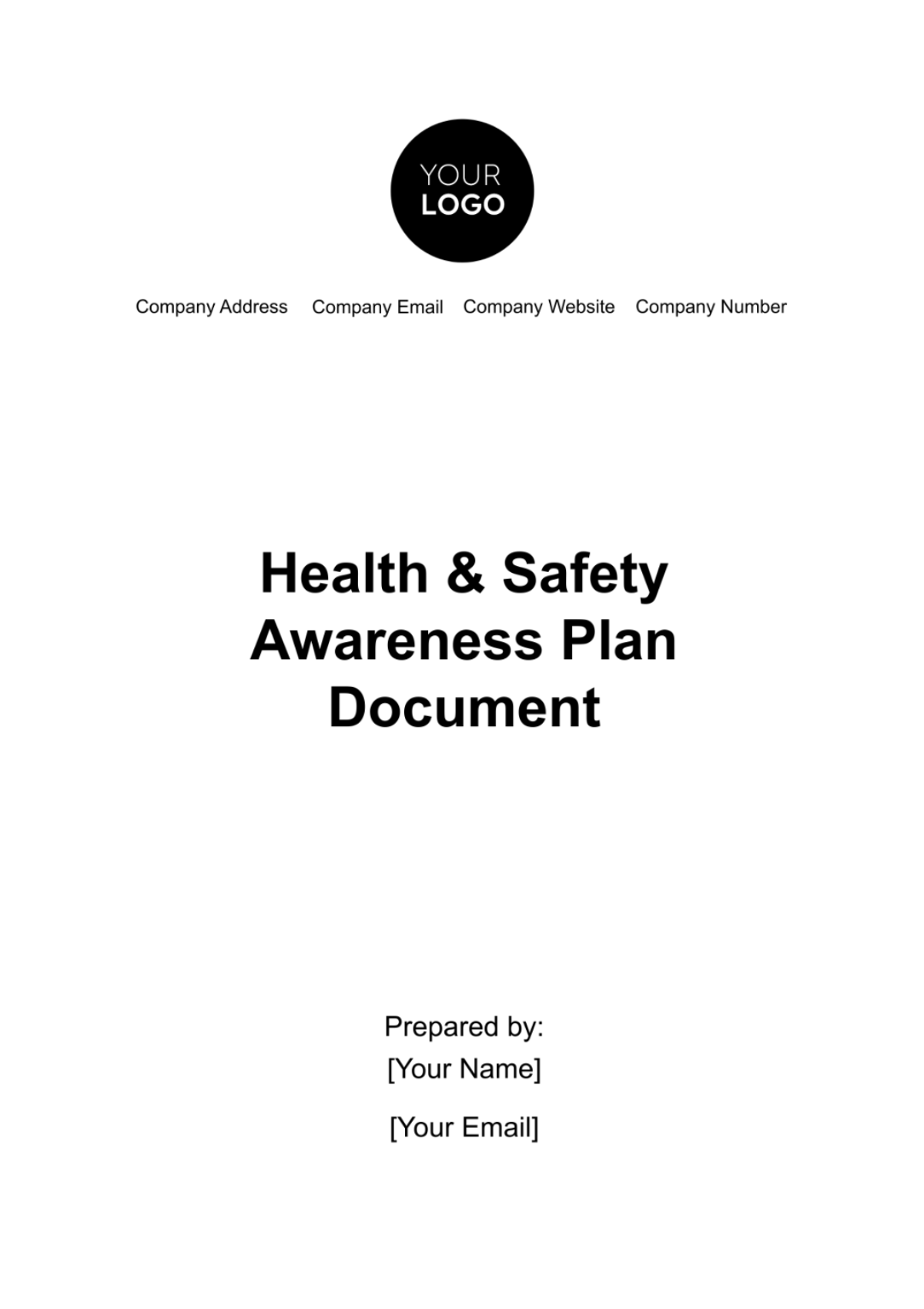
Introduction
At [Your Company Name], we are deeply committed to fostering a culture of safety, where every employee understands the importance of health and safety and actively contributes to maintaining a secure workplace. This Health & Safety Awareness Plan serves as a guide to our strategies, procedures, and responsibilities for achieving this goal.
Why Health & Safety Matters
The well-being of our employees is not only a moral imperative but also fundamental to our business success. A safe workplace minimizes the risk of accidents, injuries, and illness, ensuring that our employees can perform at their best. It also demonstrates our commitment to corporate responsibility, enhances our reputation, and can lead to cost savings by reducing workplace incidents.
The Purpose of this Plan
This document is designed to:
Outline Our Commitment: It reaffirms our commitment to health and safety, emphasizing that it is an integral part of our corporate culture.
Set Clear Objectives: We establish specific objectives to measure our progress and ensure continuous improvement.
Define Roles and Responsibilities: Clear responsibilities are assigned at all levels to ensure accountability.
Mitigate Risks: Hazard identification and mitigation strategies are detailed to protect our employees and assets.
Promote Training: We emphasize the importance of training and competence, ensuring that every employee is prepared to contribute to a safe environment.
Facilitate Communication: Effective communication channels and feedback mechanisms are outlined to keep employees informed and engaged.
Prepare for Emergencies: We provide guidance on emergency procedures and maintain essential safety equipment.
Ensure Compliance: We underscore our commitment to compliance with all relevant health and safety laws and regulations.
Promote Well-being: In addition to physical safety, we prioritize employee well-being through wellness initiatives and support resources.
Policy Statement and Objectives
Company Health & Safety Policy
We are committed to creating a safe and healthy work environment for all employees, contractors, and visitors. Health and safety are integral to our business operations and are a priority in all aspects of our work.
Principles:
Prevention: Proactively identifying and managing risks to prevent accidents and occupational illnesses.
Compliance: Adhering to all applicable health and safety laws, regulations, and best practices.
Continuous Improvement: Regularly reviewing and improving our health and safety processes and outcomes.
Objectives of the Plan
Reduce Workplace Incidents: Aim to reduce the number of workplace incidents by [25%] within the [next fiscal year].
Increase Employee Awareness: Ensure [100%] of employees receive health & safety training annually.
Enhance Reporting Systems: Develop a more efficient incident reporting system for faster response and resolution.
Promote Health & Wellness: Introduce new wellness programs focusing on mental health and ergonomic practices.
Roles and Responsibilities
Management Responsibilities
Responsibility | Description |
Senior Management | Oversee overall implementation of health & safety policies. Allocate resources for health and safety initiatives. |
Department Heads | Ensure department-specific compliance with health and safety regulations. Conduct regular departmental safety meetings. |
Supervisors | Monitor and enforce health and safety practices on the ground. Provide immediate response to safety concerns. |
Health & Safety Officer | Coordinate training programs, conduct risk assessments, and report to senior management. |
Employee Responsibilities
General Responsibilities:
Compliance: All employees must comply with health and safety instructions and procedures.
Reporting: Employees are required to report any unsafe conditions or incidents immediately to their supervisors.
Participation: Actively participate in safety training sessions and emergency drills.
Safety Advocates Program:
Selected employees from various departments will be trained as 'Safety Advocates'.
These advocates will assist in disseminating health & safety information and act as a point of contact for colleagues' safety concerns.
Risk Assessment and Management
Identification of Hazards
In our commitment to maintaining a safe workplace, we conduct regular hazard assessments across all departments. The following table provides an overview of potential hazards identified within our workplace:
Hazard Category | Description of Hazard | Mitigation Measures |
Physical Hazards | Slippery floors due to spills | Regular inspections, prompt cleanup, and use of warning signs. |
Chemical Hazards | Exposure to hazardous chemicals | Strict adherence to safety protocols and proper storage. |
Ergonomic Hazards | Improper workstation ergonomics | Employee training on ergonomic practices and adjustments. |
Biological Hazards | Risk of infectious diseases | Proper personal protective equipment (PPE) and hygiene. |
Electrical Hazards | Malfunctioning electrical equipment | Scheduled equipment inspections and maintenance. |
Fire Hazards | Presence of flammable materials | Fire extinguisher placement and employee training. |
Risk Mitigation Strategies
To mitigate the identified hazards, we have implemented the following strategies
Regular Inspections: Scheduled inspections are carried out by trained safety personnel to identify and rectify hazards promptly.
Training Programs: Employees receive comprehensive training on hazard recognition and safe practices.
PPE Provision: Appropriate personal protective equipment (PPE) is provided and mandatory in high-risk areas.
Emergency Response Plans: Detailed plans are in place for responding to different types of emergencies, including fires, chemical spills, and medical incidents.
Ergonomic Assessments: Regular ergonomic assessments of workstations are conducted to prevent musculoskeletal disorders.
Chemical Management: Strict control and labeling of hazardous chemicals and substances.
Health Surveillance: Periodic health checks for employees working in high-risk areas.
Training and Competency
Mandatory Health & Safety Training
Our company is committed to ensuring that all employees receive comprehensive health & safety training annually. Training programs cover a wide range of topics, including hazard recognition, emergency procedures, and the proper use of PPE. Below is a table outlining the mandatory training programs and their schedules:
Training Program | Frequency | Target Audience |
Basic Safety Orientation | Annually | All Employees |
First Aid & CPR Certification | Biennially | Designated First Aiders |
Hazardous Materials Handling | Annually | Specific Departments |
Fire Safety & Evacuation Drills | Quarterly | All Employees |
Ergonomics and Well-being | Annually | Office Workers |
Health & Safety Communication
Internal Communication Channels
Effective communication is vital for ensuring that health & safety information reaches all employees. We utilize various channels to disseminate crucial information:
Company Intranet: Our company intranet serves as a central hub for health & safety resources. It hosts training materials, policies, and updates.
Email Alerts: Regular email alerts are sent to employees to inform them about safety campaigns, policy changes, and upcoming training sessions.
Monthly Safety Newsletter: We publish a monthly safety newsletter that highlights safety tips, success stories, and upcoming events.
Safety Notice Boards: Notice boards are strategically placed in common areas to display safety posters, emergency evacuation plans, and incident reports.
Safety Meetings: Departmental safety meetings are held quarterly, allowing employees to discuss safety concerns and share best practices.
Feedback and Reporting Mechanisms
To encourage employees to actively participate in health & safety reporting, we have established user-friendly feedback and reporting mechanisms:
Online Incident Reporting Portal: Employees can access a secure online portal to report incidents, near misses, and hazards. The system allows for anonymous reporting if desired.
Anonymous Helpline: A dedicated helpline is available 24/7 for anonymous reporting of safety concerns or emergencies.
Safety Suggestion Box: Physical suggestion boxes are placed in key locations for employees to submit suggestions or concerns.
Safety Advocates: As part of our Safety Advocates Program, designated employees act as intermediaries for reporting safety concerns. They ensure timely communication to the appropriate channels.
Emergency Procedures and Equipment
Emergency Response Plan
Our Emergency Response Plan (ERP) is a critical component of our health & safety strategy. It provides clear and concise instructions for employees to follow during various emergency scenarios. The ERP includes:
First Aid Procedures: Instructions on providing basic first aid and the location of first aid kits.
Chemical Spill Response: Steps to contain and report chemical spills safely.
Medical Emergencies: Guidelines for responding to medical incidents, including contact information for healthcare providers.
Natural Disaster Protocols: Procedures for handling earthquakes, floods, and other natural disasters.
Communication Protocols: How to communicate during emergencies, including the use of alarms and intercom systems.
Safety Equipment and Maintenance
We maintain a comprehensive inventory of safety equipment throughout our facilities. Regular inspections and maintenance ensure the effectiveness of these safety measures. Key safety equipment includes:
Equipment | Location | Maintenance Schedule |
Fire Extinguishers | Throughout | Monthly inspections |
First Aid Kits | All Departments | Bi-weekly inspections |
Eye Wash Stations | Laboratories | Weekly inspections |
Emergency Lights | Corridors | Quarterly battery checks |
Smoke Detectors | All Buildings | Monthly testing |
Personal Protective Equipment (PPE) | Designated Areas | As needed, replaced when damaged |
Additionally, we conduct regular fire drills and emergency evacuation drills to ensure that all employees are familiar with emergency procedures and evacuation routes. These drills are conducted quarterly and documented for review.
Health & Safety Audits and Inspections
Regular Audits
To ensure compliance with our health & safety policies and identify areas for improvement, we conduct regular audits across all departments. These audits are carried out by trained safety personnel and external experts. The audit process includes:
Document Review: A comprehensive review of health & safety policies, procedures, and incident reports.
Physical Inspection: On-site inspections to assess the condition of safety equipment, emergency exits, and workspaces.
Employee Interviews: Interviews with employees to gather feedback and insights on safety practices.
Checklist Assessment: Using a detailed checklist to evaluate compliance with safety regulations.
Audit findings are documented in a standardized report format, which includes observations, recommendations, and action items. Identified issues are categorized by severity, and corrective actions are prioritized based on potential risks.
Inspection Reports and Follow-Up
Once an audit is completed, the following steps are taken:
Report Compilation: A comprehensive audit report is compiled, summarizing all findings and recommendations.
Immediate Actions: Critical issues requiring immediate attention are addressed promptly.
Action Plans: Action plans are developed for non-critical issues, outlining responsibilities, timelines, and resources needed for corrective actions.
Follow-Up Audits: Scheduled follow-up audits are conducted to verify the implementation of corrective actions.
Health & Wellness Programs
Employee Wellness Initiatives
We understand that employee well-being is not limited to physical safety alone. As part of our commitment to holistic health, we offer a range of wellness programs:
Mental Health Support: We provide confidential counseling services to employees facing stress, anxiety, or other mental health challenges.
Physical Fitness Programs: On-site gyms, yoga classes, and fitness challenges encourage physical well-being.
Nutritional Guidance: Nutritional workshops and access to healthy dining options promote balanced diets.
Ergonomics Workshops: Training sessions on ergonomics to prevent musculoskeletal issues.
Health Screenings: Regular health check-ups are offered to monitor employees' physical well-being.
Stress Reduction Workshops: Techniques to manage stress and maintain work-life balance.
Our health & wellness programs aim to foster a culture of well-being and ensure that employees have access to the support they need to thrive both in and out of the workplace.
Conclusion
This Health & Safety Awareness Plan is a testament to our unwavering commitment to the well-being of our employees. It reflects our dedication to creating a work environment where every individual can thrive and perform at their best without compromising their safety. As we move forward, this plan will serve as a living document, subject to continuous review and updates. We recognize that health and safety are evolving fields, and we will adapt to emerging best practices and regulatory changes. We firmly believe that by working together and adhering to the principles outlined in this plan, we can achieve a safer, healthier, and more productive workplace for all.
- 100% Customizable, free editor
- Access 1 Million+ Templates, photo’s & graphics
- Download or share as a template
- Click and replace photos, graphics, text, backgrounds
- Resize, crop, AI write & more
- Access advanced editor
Introducing Template.net's Health & Safety Awareness Plan Document Template. This editable and customizable template provides a structured framework for developing comprehensive health and safety awareness plans. With our Ai Editor Tool, tailor the plan to your organization's specific needs, ensuring effective communication and implementation of safety protocols.
You may also like
- Finance Plan
- Construction Plan
- Sales Plan
- Development Plan
- Career Plan
- Budget Plan
- HR Plan
- Education Plan
- Transition Plan
- Work Plan
- Training Plan
- Communication Plan
- Operation Plan
- Health And Safety Plan
- Strategy Plan
- Professional Development Plan
- Advertising Plan
- Risk Management Plan
- Restaurant Plan
- School Plan
- Nursing Home Patient Care Plan
- Nursing Care Plan
- Plan Event
- Startup Plan
- Social Media Plan
- Staffing Plan
- Annual Plan
- Content Plan
- Payment Plan
- Implementation Plan
- Hotel Plan
- Workout Plan
- Accounting Plan
- Campaign Plan
- Essay Plan
- 30 60 90 Day Plan
- Research Plan
- Recruitment Plan
- 90 Day Plan
- Quarterly Plan
- Emergency Plan
- 5 Year Plan
- Gym Plan
- Personal Plan
- IT and Software Plan
- Treatment Plan
- Real Estate Plan
- Law Firm Plan
- Healthcare Plan
- Improvement Plan
- Media Plan
- 5 Year Business Plan
- Learning Plan
- Marketing Campaign Plan
- Travel Agency Plan
- Cleaning Services Plan
- Interior Design Plan
- Performance Plan
- PR Plan
- Birth Plan
- Life Plan
- SEO Plan
- Disaster Recovery Plan
- Continuity Plan
- Launch Plan
- Legal Plan
- Behavior Plan
- Performance Improvement Plan
- Salon Plan
- Security Plan
- Security Management Plan
- Employee Development Plan
- Quality Plan
- Service Improvement Plan
- Growth Plan
- Incident Response Plan
- Basketball Plan
- Emergency Action Plan
- Product Launch Plan
- Spa Plan
- Employee Training Plan
- Data Analysis Plan
- Employee Action Plan
- Territory Plan
- Audit Plan
- Classroom Plan
- Activity Plan
- Parenting Plan
- Care Plan
- Project Execution Plan
- Exercise Plan
- Internship Plan
- Software Development Plan
- Continuous Improvement Plan
- Leave Plan
- 90 Day Sales Plan
- Advertising Agency Plan
- Employee Transition Plan
- Smart Action Plan
- Workplace Safety Plan
- Behavior Change Plan
- Contingency Plan
- Continuity of Operations Plan
- Health Plan
- Quality Control Plan
- Self Plan
- Sports Development Plan
- Change Management Plan
- Ecommerce Plan
- Personal Financial Plan
- Process Improvement Plan
- 30-60-90 Day Sales Plan
- Crisis Management Plan
- Engagement Plan
- Execution Plan
- Pandemic Plan
- Quality Assurance Plan
- Service Continuity Plan
- Agile Project Plan
- Fundraising Plan
- Job Transition Plan
- Asset Maintenance Plan
- Maintenance Plan
- Software Test Plan
- Staff Training and Development Plan
- 3 Year Plan
- Brand Activation Plan
- Release Plan
- Resource Plan
- Risk Mitigation Plan
- Teacher Plan
- 30 60 90 Day Plan for New Manager
- Food Safety Plan
- Food Truck Plan
- Hiring Plan
- Quality Management Plan
- Wellness Plan
- Behavior Intervention Plan
- Bonus Plan
- Investment Plan
- Maternity Leave Plan
- Pandemic Response Plan
- Succession Planning
- Coaching Plan
- Configuration Management Plan
- Remote Work Plan
- Self Care Plan
- Teaching Plan
- 100-Day Plan
- HACCP Plan
- Student Plan
- Sustainability Plan
- 30 60 90 Day Plan for Interview
- Access Plan
- Site Specific Safety Plan
